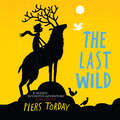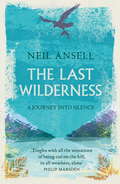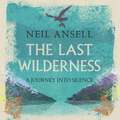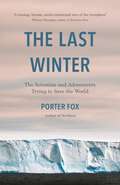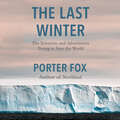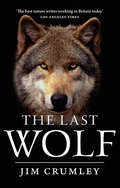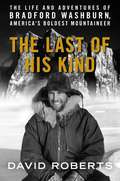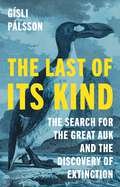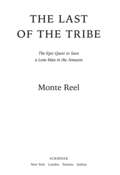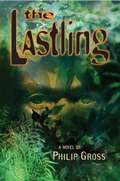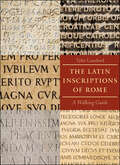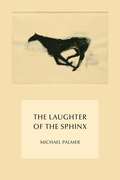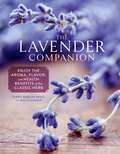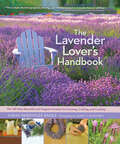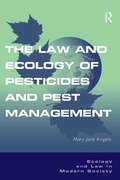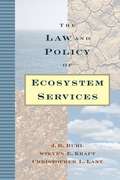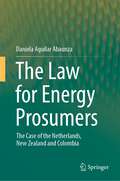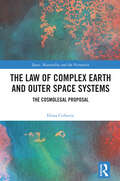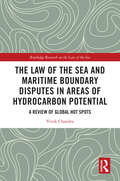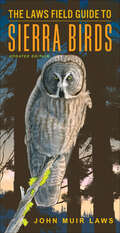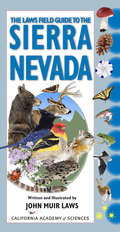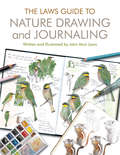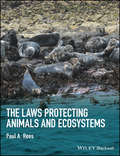- Table View
- List View
The Last Wild: Book 1 (The Last Wild Trilogy #1)
by Piers TordayThis is a story about a boy named Kester. He is extraordinary, but he doesn't know that yet. All he knows, at this very moment, is this: 1. There is a flock of excited pigeons in his bedroom. 2. They are talking to him. 3. His life will never be quite the same again...(P)2013 WF Howes Ltd
The Last Wilderness: A Journey into Silence
by Neil AnsellNeil Ansell's THE LAST WILDERNESS is a mesmerising book on nature and solitude by a writer who has spent his lifetime taking solitary ventures into the wild. For any readers of the author's previous book, DEEP COUNTRY, Robert Macfarlane's THE OLD WAYS or William Atkins THE MOOR.Shortlisted for the 2018 Wainwright Golden Beer Book PrizeShortlisted for the 2018 Highland Book Prize 'Ansell has the rare skill of combining vividly the intimacy of detail and the astonishing grandeur of this North West coastline of Scotland. Through his keen eyes we look again at the familiar with a sense of wondrous revelation' Madeleine Bunting 'Beautiful...a testimony to reticent courage' Daily MailThe experience of being in nature alone is here set within the context of a series of walks that Neil Ansell takes into the most remote parts of Britain, the rough bounds in the Scottish Highlands. He illustrates the impact of being alone as part of nature, rather than outside it.As a counterpoint, Neil Ansell also writes of the changes in the landscape, and how his hearing loss affects his relationship with nature as the calls of the birds he knows so well become silent to him.
The Last Wilderness: A Journey into Silence
by Neil AnsellNeil Ansell's THE LAST WILDERNESS is a mesmerising book on nature and solitude by a writer who has spent his lifetime taking solitary ventures into the wild. For any readers of the author's previous book, DEEP COUNTRY, Robert Macfarlane's THE OLD WAYS or William Atkins THE MOOR.Shortlisted for the 2018 Wainwright Golden Beer Book PrizeShortlisted for the 2018 Highland Book Prize 'Ansell has the rare skill of combining vividly the intimacy of detail and the astonishing grandeur of this North West coastline of Scotland. Through his keen eyes we look again at the familiar with a sense of wondrous revelation' Madeleine Bunting 'Beautiful...a testimony to reticent courage' Daily MailThe experience of being in nature alone is here set within the context of a series of walks that Neil Ansell takes into the most remote parts of Britain, the rough bounds in the Scottish Highlands. He illustrates the impact of being alone as part of nature, rather than outside it.As a counterpoint, Neil Ansell also writes of the changes in the landscape, and how his hearing loss affects his relationship with nature as the calls of the birds he knows so well become silent to him.
The Last Wilderness: A Journey into Silence
by Neil AnsellNeil Ansell's THE LAST WILDERNESS is a mesmerising book on nature and solitude by a writer who has spent his lifetime taking solitary ventures into the wild. For any readers of the author's previous book, DEEP COUNTRY, Robert Macfarlane's THE OLD WAYS or William Atkins THE MOOR.'A gem of a book, an extraordinary tale. Ansell's rich prose will transport you to a real life Narnian world that C.S.Lewis would have envied. Find your deepest, most comfortable armchair and get away from it all' CountryfileThe experience of being in nature alone is here set within the context of a series of walks that Neil Ansell takes into the most remote parts of Britain, the rough bounds in the Scottish Highlands. He illustrates the impact of being alone as part of nature, rather than outside it.As a counterpoint, Neil Ansell also writes of the changes in the landscape, and how his hearing loss affects his relationship with nature as the calls of the birds he knows so well become silent to him.(P)2018 Headline Publishing Group Ltd
The Last Winter: The Scientists and Adventurers Trying to Save the World
by Porter FoxAs the planet warms, winter is shrinking. In the last fifty years, the Northern Hemisphere lost a million square miles of spring snowpack, and high-elevation snowpacks in the western United States have decreased by nearly half since 1982. On average, winter has shrunk by a month in most northern latitudes.In this deeply researched, beautifully written, and adventure-filled book, journalist Porter Fox travels along the edge of the Northern Hemisphere's snow line to track the scope of this drastic change and how it will literally change everything-from rapid sea level rise, to fresh water scarcity for two billion people, to massive greenhouse gas emissions from thawing permafrost, and several climate tipping points that could very well spell the end of our world.This original research is animated by four harrowing and illuminating journeys-each grounded by interviews with idiosyncratic, charismatic experts in their respective fields and Fox's own narrative of growing up on a remote island in northern Maine.Timely, atmospheric, and expertly investigated, The Last Winter showcases a shocking and unexpected casualty of climate change-which may well set off its own unstoppable warming cycle.
The Last Winter: The Scientists and Adventurers Trying to Save the World
by Porter FoxAs the planet warms due to greenhouse gas emissions, winter as we know it is disappearing. In the last fifty years, the Northern Hemisphere lost a million square miles of spring snowpack and in the US alone, snow cover has been reduced by 15-30%. On average, winter has shrunk by a month in most northern latitudes.In this deeply researched and adventure-filled book, journalist Porter Fox travels along the edge of the Northern Hemisphere's snow line to track the scope of this drastic change, and ultimately, predict what the future of winter-or lack thereof-will look like.This original research will be animated by five harrowing and illuminating journeys- each grounded by interviews with idiosyncratic, charismatic experts in their respective fields and Fox's own narrative of growing up on a remote island in Northern Maine.Timely, atmospheric, and expertly investigated, THE LAST WINTER will showcase like never before the true cost of climate change.(P) 2021 Headline Publishing Group Limited
The Last Wolf
by Jim CrumleyAn elegant and imaginative account that readdresses the place of the wolf in modern Scotland from &“the best nature writer working in Britain today&” (Los Angeles Times Book Review). In The Last Wolf, Jim Crumley explores the place of the wolf in Scotland—past, present and future—and challenges many of the myths that have been regarded for centuries as biological fact. Bringing to bear a lifetime&’s immersion in his native landscape and more than twenty years as a professional nature writer, Crumley questions much of the written evidence on the plight of the wolf in light of contemporary knowledge and considers the wolf in today&’s world, an examination that ranges from Highland Scotland to Devon and from Yellowstone in North America to Norway and Italy, as he pursues a more considered portrait of the animal than the history books have previously offered. Within the narrative, Crumley also examines the extraordinary phenomenon of wolf reintroductions physically transforming the landscapes in which they live; that even the very colors of the land change under the influence of teeming grasses, flowers, trees, butterflies, birds, and mammals that flourish in their company. Crumley makes the case for their reintroduction into Scotland with all the passion and poetic fervor that has become the hallmark of his writing over the years.&“Jim Crumley&’s task is to persuade the human beings of the Highlands that all of our lives would be richer in the presence of wolves. It is, as he acknowledges, a difficult task. If everybody in Scotland was to read The Last Wolf it would become immeasurably easier.&” —Roger Hutchinson, author of The Butcher, the Baker, the Candle-Stick Maker
The Last of His Kind: The Life and Adventures of Bradford Washburn, America's Boldest Mountaineer
by David Roberts“A breezy, readable volume that is one part adventure story, one part biography. . . . Tales, stunning and stirring, of mountaineering.” —Boston GlobeIn The Last of His Kind, renowned adventure writer David Roberts gives readers a spellbinding history of mountain climbing in the twentieth century as told through the biography of Brad Washburn, legendary mountaineering pioneer and photographer. Jon Krakauer, author of Into Thin Air, has praised David Roberts, saying, “Nobody alive writes better about mountaineering”—and nowhere is that truth more evident than in this breathtaking account of the life and exploits of America’s greatest mountain climber.“A longtime friend of Washburn and a former mountaineer, Roberts is an ideal candidate for writing Washburn's biography.” —Publishers Weekly“Part of the reason that David Roberts's biography of mountain climber Bradford Washburn is titled “The Last of His Kind” is that so often Washburn was the first of his kind: He achieved nine first ascents of peaks in North America alone, taking striking photographs along the way.” —Washington Post“Excellent.” —Booklist“A well-crafted biography. . . . Roberts’s style effectively captures the suspense and danger of Washburn’s adventures. A thorough and admiring portrait.” —Kirkus Reviews
The Last of Its Kind: The Search for the Great Auk and the Discovery of Extinction
by Gísli PálssonHow an iconic bird&’s final days exposed the reality of human-caused extinctionThe great auk is one of the most tragic and documented examples of extinction. A flightless bird that bred primarily on the remote islands of the North Atlantic, the last of its kind were killed in Iceland in 1844. Gísli Pálsson draws on firsthand accounts from the Icelanders who hunted the last great auks to bring to life a bygone age of Victorian scientific exploration while offering vital insights into the extinction of species.Pálsson vividly recounts how British ornithologists John Wolley and Alfred Newton set out for Iceland to collect specimens only to discover that the great auks were already gone. At the time, the Victorian world viewed extinction as an impossibility or trivialized it as a natural phenomenon. Pálsson chronicles how Wolley and Newton documented the fate of the last birds through interviews with the men who killed them, and how the naturalists&’ Icelandic journey opened their eyes to the disappearance of species as a subject of scientific concern—and as something that could be caused by humans.Blending a richly evocative narrative with rare, unpublished material as well as insights from ornithology, anthropology, and Pálsson&’s own North Atlantic travels, The Last of Its Kind reveals how the saga of the great auk opens a window onto the human causes of mass extinction.
The Last of the Tribe
by Monte ReelThroughout the centuries, the Amazon has yielded many of its secrets, but it still holds a few great mysteries. In 1996 experts got their first glimpse of one: a lone Indian, a tribe of one, hidden in the forests of southwestern Brazil. Previously uncontacted tribes are extremely rare, but a one-man tribe was unprecedented. And like all of the isolated tribes in the Amazonian frontier, he was in danger. Resentment of Indians can run high among settlers, and the consequences can be fatal. The discovery of the Indian prevented local ranchers from seizing his land, and led a small group of men who believed that he was the last of a murdered tribe to dedicate themselves to protecting him. These men worked for the government, overseeing indigenous interests in an odd job that was part Indiana Jones, part social worker, and were among the most experienced adventurers in the Amazon. They were a motley crew that included a rebel who spent more than a decade living with a tribe, a young man who left home to work in the forest at age fourteen, and an old-school sertanista with a collection of tall tales amassed over five decades of jungle exploration. Their quest would prove far more difficult than any of them could imagine. Over the course of a decade, the struggle to save the Indian and his land would pit them against businessmen, politicians, and even the Indian himself, a man resolved to keep the outside world at bay at any cost. It would take them into the furthest reaches of the forest and to the halls of Brazil's Congress, threatening their jobs and even their lives. Ensuring the future of the Indian and his land would lead straight to the heart of the conflict over the Amazon itself. A heart-pounding modern-day adventure set in one of the world's last truly wild places, The Last of the Tribe is a riveting, brilliantly told tale of encountering the unknown and the unfathomable, and the value of preserving it.
The Lastling
by Philip GrossHaving traveled to a war-torn area of the Himalayas with her uncle to hunt exotic game, fourteen-year-old Paris befriends a lost twelve-year-old Buddhist monk and a young yeti, from whom she learns about humanity and friendship.
The Latin Inscriptions of Rome: A Walking Guide
by Tyler LansfordA collection of 15 guided walking tours of the ancient Latin descriptions found throughout Rome. Rome&’s oldest known Latin inscription dates from the sixth century BC; the most recent major specimen was mounted in 2006—a span of more than two and a half millennia. Remarkably, many of these inscriptions are still to be found in situ, on the walls, gates, temples, obelisks, bridges, fountains, and churches of the city. Classicist Tyler Lansford has collected some 400 of these inscriptions and arranged them—with English translations—into fifteen walking tours that trace the physical and historical contours of the city. Each itinerary is prefaced by an in-depth introduction that provides a survey of the history and topography of the relevant area of the city. The Latin texts appear on the left-hand page with English translations on the right. The original texts are equipped with full linguistic annotation, and the translations are supplemented with historical and cultural notes that explain who mounted them and why. This unique guide will prove a fascinating and illuminating companion for both sophisticated visitors to the Eternal City and armchair travelers seeking a novel perspective into Rome's rich history.&“This book is wonderful. . . . Lansford&’s evocative depictions of monuments, cityscape, and memorable humans have inspired me anew with the fascination of Rome.&” —Mary T. Boatwright, Duke University&“If this book is not slipped into many a Rome-bound suitcase, there is no justice in the world. I can think of few more enjoyable companions on a prowl through the city.&” —Jane Stevenson, Times Literary Supplement (UK)
The Laughter of the Sphinx
by Michael PalmerA powerful, indelible new collection by Michael Palmer--"one of America's most important poets" (The Harvard Review) Michael Palmer's new book--a collection in two parts, "The Laughter of the Sphinx" and "Still (a cantata--or nada--for Sister Satan)"--contains 52 poems. The title poem begins "The laughter of the Sphinx / caused my eyes to bleed" and haunts us with the ruin we are making of our world, even as Palmer revels in its incredible beauty. Such central tensions in The Laughter of the Sphinx--between beauty and loss, love and death, motion and rest, knowledge and ignorance--glow in Palmer's lyrical play of light and entirely hypnotize the reader. The stakes, as always with Palmer, are very high, essentially life and death: "Please favor us with a reply / regarding our one-time offer / which will soon expire."
The Lavender Companion: Enjoy the Aroma, Flavor, and Health Benefits of This Classic Herb
by Jessica Dunham Terry Barlin VesciA celebration of lavender featuring stunning photographs; favorite recipes for the kitchen, pantry, and body care products; along with fascinating lore and gardening guidance from a destination lavender farm. Lavender has long been a favorite herb with its amazing, resinous fragrance; calming qualities; and unique flavor for seasoning food. This lavishly photographed celebration of the beloved herb, written by an acclaimed lavender farmer and cooking instructor, is brimming over with inspiration and ideas for bringing the fragrance and flavor of lavender into daily life. The book profiles the most popular lavender varieties and their recommended uses, along with the history, lore, and traditional medicinal uses. More than 40 recipes showcase lavender in delicious dishes from the kitchen as well homemade craft and body products. Tips for success with lavender in the garden complete this perfect gift for every lavender lover.
The Lavender Lover's Handbook: The 100 Most Beautiful and Fragrant Varieties for Growing, Crafting, and Cooking
by Sarah Berringer Bader Janet Loughrey“I think it pisses God off when you walk by the color purple in a field somewhere and don’t notice it.” —Alice WalkerThe Lavender Lover's Handbook provides a complete checklist of the color, fragrance, size, and foliage of the 100 easiest, most stunning lavenders available today. In addition to details about spacing, planting, pruning, Sarah Berringer Bader offers tips to harvest, cook, and craft with this wonderful herb. The abundant variety, hardiness, fragrance, and culinary opportunities make lavender one of the most popular and versatile plants, and with this practical and accessible guide, it's easier than ever to grow lush lavender at home.
The Law and Ecology of Pesticides and Pest Management (Ecology And Law In Modern Society Ser.)
by Mary Jane AngeloAlthough concerns over the ecological impacts of pesticides gave rise to the environmental movement of the late 1960s and 1970s, since that time, pesticide use and its effects have been largely ignored by the law and by legal scholars. This book addresses this omission by providing a unique and serious treatment of the significance of pesticide issues in environmental law and takes an ecological perspective on the legal issues. Dealing with a wide range of questions relating to pests and pesticides, the book focuses primarily on agricultural pesticide use as the largest contaminator in the US. It also examines the legacy of past pesticide use and analyzes how recent developments in ecological science can inform the law and increase our understanding of ecology. Interdisciplinary in its approach, the book will be of interest to academics, lawyers, scientists and environmental and agricultural professionals.
The Law and Policy of Ecosystem Services
by Steven E. Kraft Christopher L. Lant J. B. RuhlThe Law and Policy of Ecosystem Services is the first comprehensive exploration of the status and future of natural capital and ecosystem services in American law and policy. The book develops a framework for thinking about ecosystem services across their ecologic, geographic, economic, social, and legal dimensions and evaluates the prospects of crafting a legal infrastructure that can help build an ecosystem service economy that is as robust as existing economies for manufactured goods, natural resource commodities, and human-provided services. The book examines the geographic, ecological, and economic context of ecosystem services and provides a baseline of the current status of ecosystem services in law and society. It identifies shortcomings of current law and policy and the critical areas for improvement and forges an approach for the design of new law and policy for ecosystem services. Included are a series of nine empirical case studies that explore the problems caused by society's failure to properly value natural capital. Among the case study topics considered are water issues, The Conservation Reserve Program, the National Conservation Buffer Initiative, the agricultural policy of the European Union, wetland mitigation, and pollution trading. The Law and Policy of Ecosystem Services is a groundbreaking look at the question of whether and how law and policy can shape a sustainable system of ecosystem service management. It is an accessible and informative work for faculty, students, and policy makers concerned with ecology, economics, geography, political science, environmental studies, law, and related fields.
The Law for Energy Prosumers: The Case of the Netherlands, New Zealand and Colombia
by Daniela Aguilar AbaunzaThis book argues that law has a vital role in shaping the electricity system to enable a more active role for consumers in liberalizsed electricity industries. To do that, this book offers a unique legal perspective of the Netherlands, New Zealand and Colombia to help understand some of the current legal approaches to prosumers and therefore the legal challenges and opportunities facing. Law and regulation have the role of creating a level playing field for emerging participants, such as prosumers, to participate and compete in the market together with traditional actors, bringing not only more competition but also representing a more sustainable, environmental and democratic way to supply energy. Furthermore, law and regulation have the role of responding to innovation and creating space for technological advances to procure the changes in the industry without delay. This book examines some of the legal barriers for the raise of energy prosumers. The traditional role of the distributor when responding to increasing distributed generation in the network; prosumers unable to decide to whom they can sell their electricity to; the price of the energy or even whether to participate more actively in demand response programs. A further issue is the lack of clarity about whether small prosumers are entitled to consumer protection rights and legal challenges regarding configuration, access to the network, access to markets and strict unbundling rules for community energy projects. This book provides a clear, analytical, and informed approach to understanding the regulatory framework around energy prosumers. It will appeal to policy makers, lawyers, individuals, business entrepreneurs or communities wanting to engage in energy projects, as well as academics, researchers and students
The Law of Complex Earth and Outer Space Systems: The Cosmolegal Proposal (Space, Materiality and the Normative)
by Elena CirkovicThis book offers a paradigm-shifting exploration of lawmaking for the complex interactions between Earth systems and outer space. Drawing on complex systems science, posthuman approaches, and plural ontologies, the author proposes a reimagining of law and governance for the cosmic age. Through the “cosmolegal” perspective, this study embraces the inherent uncertainties and complexities of Earth-space interactions. From Arctic methane craters to orbital debris, the book weaves together scientific insights, landscape architecture, legal theory, and doctrine to address pressing environmental challenges that span Earth and beyond.While legal scholarship has increasingly engaged with Earth System Science, it typically treats outer space as distinct from Earth’s environment. However, Earth’s existence and complex systems are fundamentally intertwined with and emerge from outer space. This book argues that a legal framework for Earth’s systems needs to include outer space.At its core, the book advocates for a “complexification” of law, calling for greater epistemic humility in legal thought and practice. Thoughtful and provocative, this work invites readers to reconsider fundamental assumptions about law, nature, and agency beyond the human in an era of planetary change. The cosmolegal approach aims to shift legal imagination and understanding, positioning human law as just one of many actors within the cosmos.This original work will appeal to scholars of legal theory and environmental law, as well as those interested in posthumanism, ecology, and materialism.
The Law of the Sea and Maritime Boundary Disputes in Areas of Hydrocarbon Potential: A Review of Global Hot Spots (Routledge Research on the Law of the Sea)
by Vivek ChandraThe United Nations Convention on the Law of Sea (‘UNCLOS’) is hailed as one of the most significant multilateral legal agreements executed in the past few decades. However, its shortcomings are neither trivial nor inconsequential, especially regarding maritime boundary disputes involving hydrocarbon resources. This monograph examines the relationship between UNCLOS and maritime boundaries in five non-polar regions, encompassing almost 90% of global unresolved disputes involving offshore hydrocarbon development. The regions, which include the eastern Mediterranean, the Caspian Sea, the Persian Gulf, northeast Asia, and the South China Sea, were chosen for their oil and gas resources potential and recent military skirmishes that have the potential to lead to wider regional confrontations. The book addresses each region’s maritime boundary status in the context of specific articles within UNCLOS that have been exploited by disputing states to justify their overlapping claims. The history and future applicability of multilateral Joint Development Area agreements for each region are evaluated for their potential to provide a cooperative solution to resolve ongoing tensions. Highlighting the limitations of current ‘gun-boat’ diplomacy, the monograph makes practical suggestions for new paradigms for resolving outstanding disputes, promoting lasting peace and generating economic benefits resulting from resource development.
The Laws Field Guide to Sierra Birds
by John Muir LawsUpdated for the first time in twenty years with completely redrawn birds and more, the classic and remarkably easy-to-use guide for identifying birds in the Sierra Nevada.John Muir Laws began his lifelong project of connecting people to the natural world when he noticed that novice birders often distinguish birds by color and size rather than by family, genus, and species. Inspired by his observation, he created a guide to Sierra birds that assumes no prior birding knowledge on the part of the reader. The guide became the most popular of its kind, used frequently by local birders and visitors alike. Now updated for the first time in twenty years, The Laws Field Guide to Sierra Birds—originally published as Sierra Birds: A Hiker’s Guide—features fully redrawn color illustrations throughout.Color-coded keys eliminate the time-consuming frustration of thumbing randomly through a guide, and a cross-index is also included for more advanced birders. All this in a format that is simply organized, lightweight, and small enough to tuck inside a pocket. Featuring more than 200 species, The Laws Field Guide to Sierra Birds is a friendly, invaluable resource for anyone seeking to identify birds in the Sierra Nevada mountain range.
The Laws Field Guide to the Sierra Nevada
by John Muir LawsIn this groundbreaking and meticulously field-tested guide, the rich variety of Sierra life—trees, wildflowers, ferns, fungi, lichens, fish, reptiles, amphibians, birds, mammals, and insects—comes alive.Easy-to-use features include:Intuitive organization, color tabs, and simple keys;Similar-looking species side by side;Over 2,800 full-color illustrations;Range maps of species that are otherwise difficult to distinguish;Index of common and scientific names;Lightweight and compact—ideal for backpacking.Impressively detailed and comprehensive, the guide includes:More than 1,700 species;Descriptions of behavior, adaptations, and interactions between species;Species and topics not found in most guides, including aquatic life, spiders and webs, plankton, plant galls, bark beetle galleries, animal tracks and evidence, seasonal star charts, weather patterns, and cloud formations.
The Laws Guide to Nature Drawing and Journaling
by John LawsThe ultimate guide to nature drawing and journaling! A potent combination of art, science, and boundless enthusiasm, the latest art instruction book from John Muir Laws (The Laws Guide to Drawing Birds) is a how-to guide for becoming a better artist and a more attentive naturalist. In straightforward text complemented by step-by-step illustrations, dozens of exercises lead the hand and mind through creating accurate reproductions of plants and animals as well as landscapes, skies, and more. Laws provides clear, practical advice for every step of the process for artists at every level, from the basics of choosing supplies to advanced techniques. While the book’s advice will improve the skills of already accomplished artists, the emphasis on seeing, learning, and feeling will make this book valuable—even revelatory—to anyone interested in the natural world, no matter how rudimentary their artistic abilities.
The Laws Protecting Animals and Ecosystems
by Paul A. ReesThere is currently no basic text in wildlife law suitable for the wide range of courses in wildlife conservation and animal welfare at both bachelors and masters level, or for the large number of people who work in conservation and animal welfare; The Laws Protecting Animals and Ecosystems fills the gap in this significant market for a basic law text applicable to students and professionals whose primary training is in biology but who require a basic understanding of the laws relating to the protection of animals and ecosystems. The text is applicable to a wide range of subjects, including wildlife conservation, animal handling, animal welfare, animal husbandry, and veterinary science. This foundational text supports those studying animal and ecosystem law by providing an overview of the basic legal principles, national and international laws, terminology, the legal mechanisms used to protect animals and ecosystems, and a compendium of the major animal welfare and conservation laws in major English speaking countries. Dr. Rees has been teaching wildlife law for 20 years and ecology for over 35 years and is ideally placed to write this book.
The Laws of Every-day Life
by H.O. Arnold-ForsterArnold-Forster, using thoughtful examples, presents foundational ideas on laws of nature and reason, economics, community life, and work.
